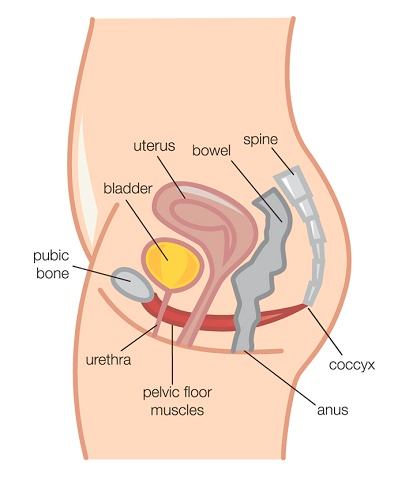Pelvic Floor Exercises
Ladies, let’s talk pelvic floor! Based on US data, 1 in 7 women aged 30-39 will have a problem with their pelvic floor1. This jumps to 1 in 3 women aged 50-59, and continues to become more frequent with advancing age1. Pelvic floor weakness is not only a women’s issue though. It can affect men too, though less frequently.
We all hear about our pelvic floor but what exactly is it? The pelvic floor is a ‘sling’ made up of various muscles in your pelvis that help support your bladder, bowels, and uterus (see image). They also work with your abdominal core muscles to stabilise your spine. Any time you lift something, laugh, cough, sneeze, or exercise, the pressure increases inside your abdomen and pelvis. When the pelvic floor is working properly, the muscles will tighten to help control that pressure. If it’s a bit weak, you may get symptoms such as accidentally leaking urine (particularly when laughing, coughing or sneezing), and frequently or urgently needing to go to the toilet. More severe weakness in the pelvic floor can lead to losing control of your bowel or bladder, or other more severe symptoms. You can read more about the symptoms here.
Problems in your pelvic floor can arise for a variety of reasons. In women, the most common cause is pregnancy and childbirth. Unsurprisingly, during this time the pelvic floor gets stretched, sometimes torn or cut, and it doesn’t always regain the strength it had previously. Other contributors include inactivity, back pain, and frequent straining (e.g. constipation). It is also normal for muscles to weaken with age.
Many women have heard of, or been taught, pelvic floor exercises (also known as Kegel exercises). Once you know what they should feel like, they are quick and easy to do and can be done in any position. I encourage you to spend some time learning how to do pelvic floor exercises properly, or at least refresh your memory. Visit here for a detailed explanation. Pelvic floor exercises have been shown to reliably help with urinary (bladder) incontinence2. The team at Hilton Chiropractic are well trained in rehabilitation and can guide you through the process too if you need extra help. In fact, sometimes we recommend pelvic floor exercises to help train up your core muscles, which can help with lower back pain.
We’ve all heard that ‘prevention is better than cure’, and certainly when it comes to the pelvic floor this applies! Even if you don’t have any problems, start exercising now to prevent problems later on! This is especially true if you are female, as problems are so frequent in almost any age group. If you’re already experiencing incontinence, firstly get it checked out by your GP, and then get started on some pelvic floor exercises!
Dr Sasha Aspinall
Hilton Chiropractic
References
1. Wu JM, Vaughan CP, Goode PS, Redden DT, Burgio KL, Richter HE, Markland AD. Prevalence and Trends of Symptomatic Pelvic Floor Disorders in U.S. Women. Obstet Gynecol. 2014: 123 (1): 141-148.
2. Dumalin C, Hay-Smith EJC, Mac Habee-Seguin G. Pelvic floor muscle training versus no treatment, or inactive control treatments, for urinary incontinence in women. Cochrane Database of Systematic Reviews 2014, Issue 5.
http://www.pelvicfloorfirst.org.au/



